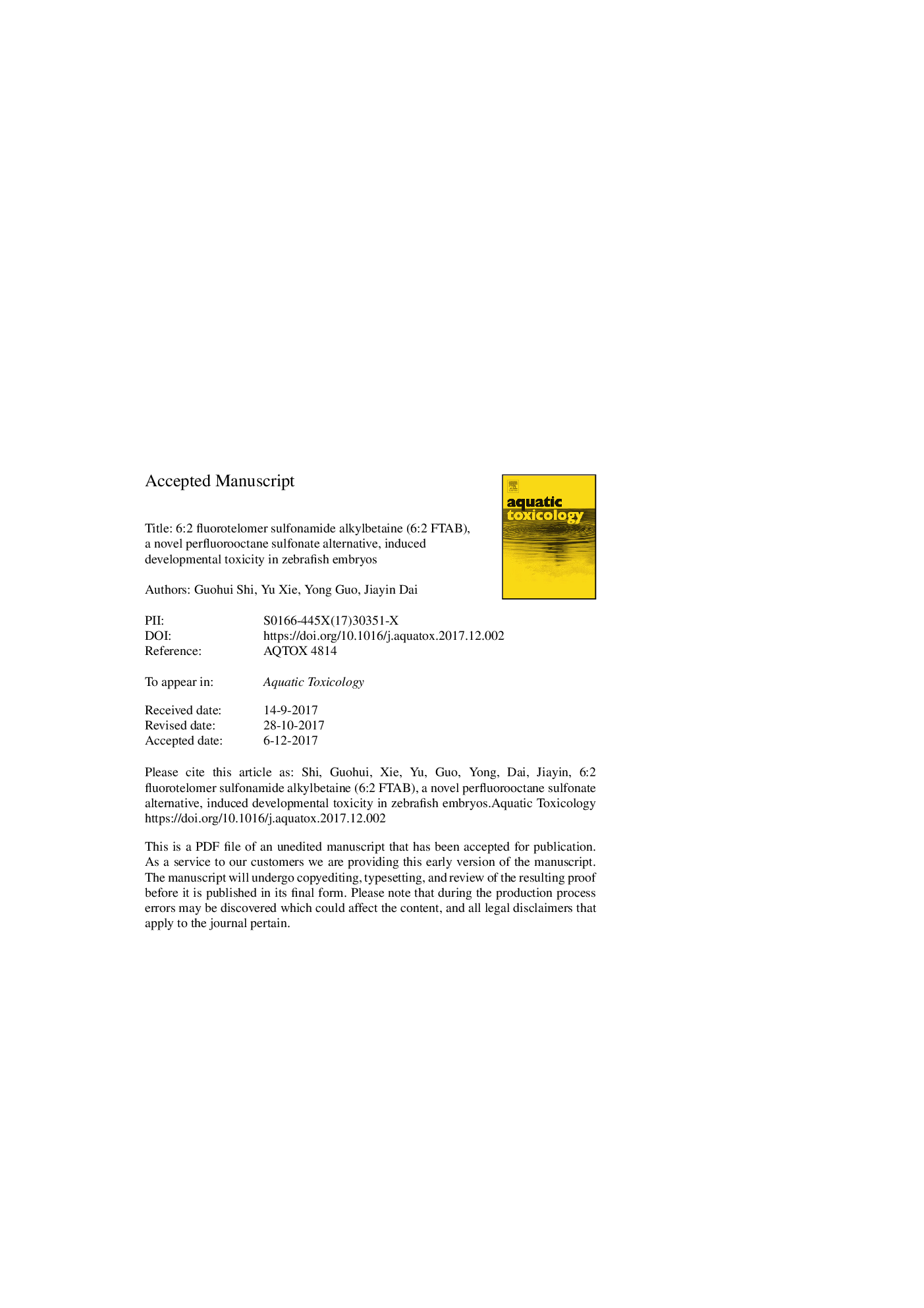| کد مقاله | کد نشریه | سال انتشار | مقاله انگلیسی | نسخه تمام متن |
|---|---|---|---|---|
| 8883855 | 1625910 | 2018 | 42 صفحه PDF | دانلود رایگان |
عنوان انگلیسی مقاله ISI
6:2 fluorotelomer sulfonamide alkylbetaine (6:2 FTAB), a novel perfluorooctane sulfonate alternative, induced developmental toxicity in zebrafish embryos
دانلود مقاله + سفارش ترجمه
دانلود مقاله ISI انگلیسی
رایگان برای ایرانیان
کلمات کلیدی
موضوعات مرتبط
علوم زیستی و بیوفناوری
علوم کشاورزی و بیولوژیک
علوم آبزیان
پیش نمایش صفحه اول مقاله

چکیده انگلیسی
6:2 fluorotelomer sulfonamide alkylbetaine (6:2 FTAB) is a major component of Forafac®1157, a novel perfluorooctane sulfonate (PFOS) alternative used globally in aqueous film forming foams (AFFFs). Although 6:2 FTAB has been recently detected in the aquatic environment, its toxic effects on aquatic organisms remain unclear. Here, zebrafish embryos were exposed to various concentrations of 6:2 FTAB (0, 5, 10, 20, 40, 60, 80, and 100â¯mg/L) from 6 to 120â¯h post-fertilization (hpf) to investigate its developmental toxicity and possible mechanism of action. Results showed that exposure to 40â¯mg/L or higher concentrations of 6:2 FTAB significantly decreased the survival percentage and increased the malformation percentage. The median lethal concentration (LC50) at 120 hpf was 43.73â¯Â±â¯3.24â¯mg/L, and the corresponding benchmark dose lower limit (BMDL) of lethal effect was 33.79â¯mg/L. These values were both higher than those for PFOS, supporting the notion that 6:2 FTAB is less toxic than PFOS to zebrafish embryos. The most common developmental defect in 6:2 FTAB-treated embryos was rough-edged skin/fins. TUNEL assay showed that 6:2 FTAB exposure induced cell apoptosis in the tail region compared with that of the control, which might explain the rough-edged skin/fins. The increased transcriptional levels of p53, bax, and apaf1 and the increased activities of caspase-3, -8, and -9 provided further evidence of 6:2 FTAB-induced apoptosis. We also analyzed the effects of 6:2 FTAB on oxidative stress and the immune system. Results showed that reactive oxygen species and malondialdehyde accumulated in concentration-dependent manners after exposure to 6:2 FTAB, and antioxidant enzyme activities (catalase and glutathione peroxidase) also changed. Exposure to 6:2 FTAB also altered the transcriptional levels of ccl1, il-1β, il-8, tnfα, ifn, and cxcl-c1c, which play important roles in the innate immune system. Collectively, our data suggest that 6:2 FTAB exposure can induce cell apoptosis, oxidative stress, and immunotoxicity, thus highlighting the developmental toxicity of 6:2 FTAB in zebrafish embryos.
ناشر
Database: Elsevier - ScienceDirect (ساینس دایرکت)
Journal: Aquatic Toxicology - Volume 195, February 2018, Pages 24-32
Journal: Aquatic Toxicology - Volume 195, February 2018, Pages 24-32
نویسندگان
Guohui Shi, Yu Xie, Yong Guo, Jiayin Dai,